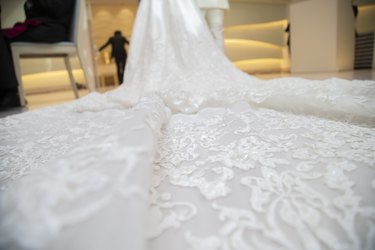
Nothing looks quite like satin cloth, which is valued for its incredible softness and silky sheen. It is the fabric of choice for dressy evening gowns and ties and makes elegant and casual tops and slacks. Silk clothing requires special care, though, and tossing it into the washing machine and laundering it like other garments will likely ruin it. What are the best ways to care for satin clothing?
Washing Satin Cloth Garments
Video of the Day
Satin can be made from different materials, like silk, cotton, wool, rayon or polyester. The weaving technique is what gives it that shimmery shine. Some satins are dry clean only, while others can be hand-washed or put in the washing machine. No matter what you do, be sure to always read the manufacturer's label first.
Video of the Day
To get oil stains out of washable satin, remove what you can with a clean cloth, cover the oil with some flour and leave it for an hour. Use a soft, clean brush to remove the flour and spray on a stain pretreatment.
Regular dirt can be removed from satin, but remove any excess debris first with a soft-bristle brush. Drip a bit of mild liquid soap onto the satin and rub carefully with a soft cloth. Once you see a few bubbles appear, dab at the spot with a clean, soft cloth until it disappears and then hand-wash or launder as directed.
What About Ironing Satin?
You might not think so, but satin cloth is very wrinkle-resistant. Linens and cotton blends are the most wrinkle prone and are sometimes harder to iron. Plain weaves, broadcloths and poplins are the second category of fabrics most likely to wrinkle. This is why it can be best to have those fabrics professionally cleaned and pressed.
You can sometimes dry satin for short amounts of time on low heat settings in dryers, but you should remove them promptly to air dry on a drying rack. Never dry them outside, as that could cause the items to discolor. When ironing satin, set the temperature between 110 and 150 degrees Fahrenheit. Turn the item inside out and if it is made from polyester, you can spray it with a bit of water before proceeding.
Move the iron quickly across the satin and do not apply a lot of pressure. Use smooth, even strokes and the wrinkles should come out. Avoid spritzing water onto the wrinkles if the satin is made from silk or wool. When finished, hang up the dress or other garment and close any buttons or zippers.
Ironing Other Kinds of Materials
Cottons and linens wrinkle the most, and you can iron them at higher temperatures of 150 to 200 degrees Fahrenheit. Also, feel free to sprinkle on water or steam from your iron or a spray bottle. Spray starch is also good to use with cotton and linen and can keep the wrinkles from setting back in as quickly.
Nylon, acrylic and acetate should be ironed at 110 degrees because they are more susceptible to burning. Also, iron these on the opposite side and avoid using water or steam. Many people like to protect these fabrics and satins by putting down cotton cloth between the garment and the iron. Never iron velvet or sequins, though. Those kinds of dresses are best left to the dry cleaner.